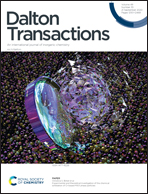Copper(ii)–hydroxide facilitated C–C bond formation: the carboxamido pyridine system versus the methylimino pyridine system†
Abstract
A copper(II)–hydroxide-induced carbon–carbon bond formation reaction is explored with the synthesis of an asymmetric carboxamido–methylimino pyridine Cu(I) complex of [CuI(py(N–C![[double bond, length as m-dash]](https://www.rsc.org/images/entities/char_e001.gif) O)(N
O)(N![[double bond, length as m-dash]](https://www.rsc.org/images/entities/char_e001.gif) C–C)ph2Me2)2]− (12). Two imine-methyl groups are coupled to form a bridged C–C bond (N
C–C)ph2Me2)2]− (12). Two imine-methyl groups are coupled to form a bridged C–C bond (N![[double bond, length as m-dash]](https://www.rsc.org/images/entities/char_e001.gif) C–C–C–C
C–C–C–C![[double bond, length as m-dash]](https://www.rsc.org/images/entities/char_e001.gif) N) at the methyl positions with the reduction of two Cu2+ center ions to Cu+. The reaction is checked with three dicarboxamido pyridine [CuII–OH] complexes, with which dinuclear Cu(I) complexes of [Cu2(py(N–C
N) at the methyl positions with the reduction of two Cu2+ center ions to Cu+. The reaction is checked with three dicarboxamido pyridine [CuII–OH] complexes, with which dinuclear Cu(I) complexes of [Cu2(py(N–C![[double bond, length as m-dash]](https://www.rsc.org/images/entities/char_e001.gif) O)2ph2R2)2]2− (R = methyl (3), methyl and allyl (6)) and trinuclear [CuII–CuI–CuII] complex of [Cu3(⊂20-py(N–C
O)2ph2R2)2]2− (R = methyl (3), methyl and allyl (6)) and trinuclear [CuII–CuI–CuII] complex of [Cu3(⊂20-py(N–C![[double bond, length as m-dash]](https://www.rsc.org/images/entities/char_e001.gif) O)2ph2dienMe3)2]+ (9) are obtained. The reactivities of the [CuII–L] (L = DMF, OH−) complexes in dicarboxamido pyridine, carboxamido–methylimino pyridine and dimethylimino pyridine systems are discussed in terms of the electron delocalization properties of ligands. A cooperative metal–ligand (Cu2+ and enamide ligand) interaction is proposed based on the characterization of ligated Cu(II) intermediates with the techniques of X-ray crystallography, UV-vis spectroscopy, cyclic voltammogram, EPR spectroscopy, and DFT calculations.
O)2ph2dienMe3)2]+ (9) are obtained. The reactivities of the [CuII–L] (L = DMF, OH−) complexes in dicarboxamido pyridine, carboxamido–methylimino pyridine and dimethylimino pyridine systems are discussed in terms of the electron delocalization properties of ligands. A cooperative metal–ligand (Cu2+ and enamide ligand) interaction is proposed based on the characterization of ligated Cu(II) intermediates with the techniques of X-ray crystallography, UV-vis spectroscopy, cyclic voltammogram, EPR spectroscopy, and DFT calculations.



 Please wait while we load your content...
Please wait while we load your content...